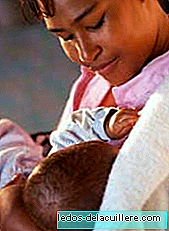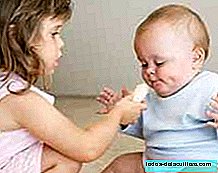
In less than a week we have learned of the arrest of two men (between 20 and 35 years) for alleged crimes of pornography and corruption of minors: one in a municipality in Barcelona - he was a Primary teacher -, another in Córdoba.
We talk about grooming, or sexual harassment of a minor through the Internet. We have read in Stop Grooming that this phenomenon arises strongly, although only 1% of cases are reported.
One percent is to start to shake ... But we should not let fear take hold of us, and we should not do as if the problem were not with us. It is clear that we do not want it to happen, but if we do not lay the foundations, our children can be victims as others are
As those responsible for SafeChildren Guardian told us, we parents know very well the risks of what "the real world" is for us (for our children network relationships are as real as their bike rides with friends). Well, I say that It's time for us to find out and solve this, because it is not logical that we be the last to know about the problems that children may have due to misuse of the Internet.
We would not want there to be juvenile predators lurking behind a false profile on social networks, but there are. We would not want our children to ever run into one of them, but these people have plenty of time to track the Internet and discover possible victims behind very vulnerable little people.
The basic self protection tips when browsing are safeguard privacy, and respect the privacy of others (Here you will find much more detailed information). But in addition, I can add that when a child is faced with a problem of sexual harassment should know how to say no and ask for help.
When thinking about grooming, we should not underestimate the consequences it may have on the child, his family, and the environment in which he usually develops. We are all exposed, now, the chances of suffering decrease when you have information, and we know how to protect. For example, it is a good idea to stop sharing or sending compromised or intimate images: as funny as it may seem, and surely it is - considering that we are talking about pre teenagers and teenagers - the network's own characteristics make it possible to lose control over the content.
Desires for popularity sometimes take their toll
Well, I know that images are not always shared to be more popular, although in my opinion many people develop problems with the ego in parallel to their immersion in Social Networks. The humans We can anticipate the consequences of our actions (We can have said, although we do not always do it), we are also good - if we want - to think before acting.
But what about the children? What if they are in that age when they have not yet developed abstract thinking? And what happens to those teenagers eager to "fit" among their peers and find a place in society?
The reason that Social Networks for adults do not allow access to children under 14 years (something that we skip too often), has to do with this I just discussed above. "To use a tool, you should not only control the technique, you must also know how to avoid getting hurt, so as not to end up damaged."
As I mentioned above, and as explained in this very interesting post a year ago, sexual predators spend a lot of energy and a lot of time looking for minors to contact and to gain confidence, it is not surprising that more times of those we would like to succeed. But what prevents us from learning more and teaching children self-protection?

A danger and more than one way to expose yourself to it
Reading HEADLIGHTS, we have learned that there are direct stalkers (identify minors and establish contact, then ask for images or press for the victim to connect the webcam; opportunistic stalkers (photos of sexual content found through the internet, serve as an object of harassment, to blackmail); Y specific stalkers (They want to obtain sexual images of the child and establish sexual contact with him).
The latter are the most difficult to identify, so the following information on the phases by which they harass children may be useful.
- Hitch: they know the tastes of the possible victims to adapt and favor that the latter feel identified with the false profile, it is about gaining trust.
- Loyalty: ensure that children want to continue talking with them; The issues of interest of the victims come into play here, to get more information about their family that "opens the door" to a relationship in which confidences are included.
If you remember, I talked about this topic when I was reviewing the movie “Coraline's Worlds”, since for me it establishes a fairly exact parallelism with what happens in real life. In the absence of a relationship of trust with parents, or due to various problems, minors need to vent with someone who understands them
- Seduction: seduction and manipulation, actions that are possible thanks to all the information available. Sex appears in the conversations, and sometimes pictures of other children are used to press… “if they have done it you should do it too”.
- Bullying: With all the information and images, it is easy to coerce and threaten the child to get physical or virtual sex.
As you can see, the issue is like to be taken seriously, and it is very necessary that we all know how to act to avoid contacts, or to deal with bullying episodes, in the latter case all possible evidence will be saved: conversations, messages, screenshots; on the other hand it will not yield to blackmail (at this point it would be necessary to reiterate the need to establish a climate of trust at home) and the responsible adults, who will ask for help from the Safe Internet Center, the Civil Guard, or the National Police.
Safety first
And that is why, since Que no te Den (specific portal to inform about Protégeles' grooming, they have developed a Decalogue, whose last two points we have just commented. The rest, below:
- Reject messages of a sexual or pornographic nature. It demands respect.
- You should not post photos of yourself or your friends on public sites.
- Use private profiles on social networks.
- When you upload a photo on your social network make sure that does not have a sexual component. Think about whether you are willing to see that photo for everyone to see and forever.
- Do not accept in your social network people who have not seen physically and who do not know well. If you have 200, 300 or 500 friends you are accepting people who are not really friends or family of yours.
- Respect your own rights and those of your friends. You have the right to the privacy of your personal data and your image: do not publish or make public those of others.
- Keep your computer safe: use programs to protect your computer against malicious software.
- Use really private and complex passwords. Do not include in your nicknames and identification data such as your age, etc.
Lately there is talk that 15 percent of children between the ages of 10 and 17 have received online sexual proposals, but here it is not so much about the increase in these crimes (but also), but about our ability to react, and our (and that of our children) network behavior. Can we achieve a healthier and safer Internet? It depends on whether we are willing to commit to it, I would say.
Images | Waag Society, Jim Sneddon
More information | Don't give it to him, Stop Grooming, Safe Internet Center
In Peques and More | It is dangerous not to educate minors and not worry about what they do or do on the Internet. Pere Cervantes and Oliver Tauste












